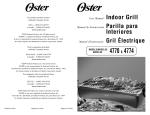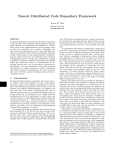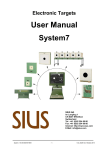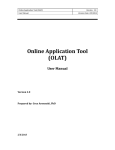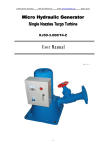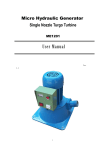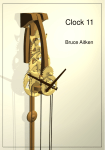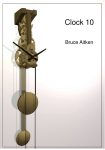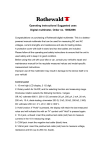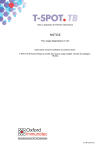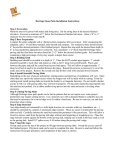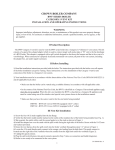Download Wetlands Operation and Maintenance guide
Transcript
WETLANDS Operation & Maintanence Guide STORMWATER DEVICE INFORMATION SERIES WETLANDS Operation & Maintanence Guide STORMWATER DEVICE INFORMATION SERIES What are constructed wetlands? Constructed wetlands are large shallow planted ponds that filter stormwater runoff, slow flows and help control flooding downstream. Similar to natural wetlands, they look attractive and provide home and shelter to wildlife. Constructed wetlands help remove sediments, nutrients and contaminants from incoming stormwater before discharging to downstream stormwater system or waterways. WARNING - CONTAMINATED SOIL Constructed wetlands treat stormwater run-off, so will collect contaminants in the sediments of the pond and forebay. All material removed from these sites should be tested for contaminants before being disposed of at a suitable secure landfill. This guide offers a general description of constructed wetlands. Each constructed wetland is specifically designed to suit a particular site, so construction details will be on design and site construction plans. Correct construction levels are crucial for supplying suitable drainage for wetland plants. How and when should maintenance be carried out? Constructed wetlands need to be maintained in two main ways. Firstly, so they continue to work as designed (filtering stormwater, slowing flows and controlling downstream flooding) and secondly, to look attractive. A full inspection of constructed wetlands should take place a year after construction is completed. This may be carried out by the construction contractor to coincide with the end of the defects liability period. The tables below give only typical timelines and actions for maintaining constructed wetlands. This is a general guide - each wetland should have its own detailed maintenance plan to suit the particular catchment size, pollutant loads and inflows. 1 Eight key components of a constructed wetland WETLANDS Operation & Maintanence Guide 5. Plants STORMWATER DEVICE INFORMATION SERIES Usually native plants, in the pond and on littoral shelf. Species chosen to suit various water level zones in wetland. (For suitable species and planting guidelines, refer to ARC Technical Report TR2009/083 Landscape and Ecology Values within Stormwater Management) 7. Emergency overflow Structure to allow extreme heavy rain flows to bypass wetland and drain downstream, to prevent overtopping of wetland banks. May be in outlet riser or separate. 8. Anti-seep collars Collars are fitted to all pipework to prevent pond leakage and potential bank collapse from erosion. 1. Inlet Inlet pipe, receiving runoff. Erosion controls at inlet (rip rap, energy dissipaters) slow flows. Debris screens or trash racks capture rubbish. 2. Sedimentation forebay (if included) Forebay helps slow runoff and sediment drops to the bottom. Separated from main pond by a bund or low dam. 3. Main wetland Shallow wide pond of variable depth to 1m, planted with aquatic species. Fine sediments settle to bottom and contaminants such as oil and grease break down. 4. Shallow wetland area (Littoral shelf) Shoreline of the pond, planted with swamp species submerged at times. Plants take up nutrients (nitrogen and phosphorous) as well as slow flows and trap sediment. 6. Risers/outlets Outlet riser pipe or weir for discharge of treated runoff. Risers may have scruffy dome to trap debris, or baffles/skimmer to prevent water life and debris from flowing downstream. Some risers have drain-down valve for maintenance. 2 WETLANDS Operation & Maintanence Guide MAINTENANCE SCHEDULE Timing Following storms STORMWATER DEVICE INFORMATION SERIES Component Action Inlet • Inspect and remove rubbish and debris from inlets. • Check area around inlet, especially energy dissipation (rip rap) structures for erosion and cracking, and if present, repair. Trash racks and debris screens (if fitted) • Inspect and clear all litter, including leaves, rubbish, branches and any other material that would block flows. Check racks for corrosion and replace if necessary. Sediment forebay • Check the forebay for accumulated sediment. In general the forebay should be dredged if sediment fills over 50% of design volume. • Test sediments for contaminants (eg heavy metals, PAHs) prior to dredging and dispose of sediment to landfill or similar suitable for contaminant levels. Bund • Check for erosion or instability and repair if required. Risers, control structures, grates, outlet pipes, skimmers, weirs and orifices • Inspect control structures, weirs, orifices, outfall pipes for leaks and blockages. Blockage could be sediment build up, floating debris, rubbish. • Control structures could be overgrown with vegetation. • Clear and remove all blockages to avoid local flooding. Areas around control structure need to be clear of vegetation and rubbish to maintain stormwater flow. A boat may be required to access the outlet. • Inspect outflow pipes for leaky joints or soil piping erosion. • Check if anti-seep collars need repair or replacement. • Check outfall and water discharge areas for erosion and restore and stabilise erosion. • Check energy dissipaters are adequate. Emergency overflow or spillway • Check emergency overflow path remains clear of debris and blockages, and remove any blockages. Check flow path for erosion and repair as necessary. Structural repairs must be repaired immediately to avoid catastrophic failure. 3 WETLANDS Operation & Maintanence Guide MAINTENANCE SCHEDULE cont... TIMING Following storms Monthly STORMWATER DEVICE INFORMATION SERIES COMPONENT ACTION Erosion and bank stability • Inspect banks for settlement, erosion, scouring, cracking, sloughing, seepage and rilling. • Remove woody vegetation growth (unless species specifically included in pond planting plans) to avoid future root damage to banks. Removal will require bank material replacement and repair, compacted to design specification of maximum 90% dry soil density. • Inspect for pedestrian and cycle traffic or pathways on banks. • Either restrict traffic by closing paths off, or provide suitable resistant ground cover to avoid erosion from traffic. Water body • Remove rubbish and other floating debris from wetland pond. • Inspect for algal blooms (usually dense water discolouration or surface scum) or fish kills – these could indicate water has extremely low levels of oxygen (eutrophication), or high nutrient loads or pollutants. • Test water quality if these problems suspected. Wildlife • Control pest species so they do not threaten birds and aquatic life of the wetland. • Remove dead animals, especially water birds, to prevent disease spread. Wet areas where mosquito (mosquito larvae) could breed need careful maintenance. Soil • Inspect for loss of soil on wetland banks from erosion. If plants are struggling to grow soil fertilizer may be required, but extra care must be taken to prevent fertilizer from entering wetland and local waterways. Inlet • Inspect and remove rubbish and debris from inlets. Trash racks and debris screens (if fitted) • Inspect and clear all litter, including leaves, rubbish, branches and any other material that would block flows. • Check racks for corrosion and replace if necessary. 4 WETLANDS Operation & Maintanence Guide MAINTENANCE SCHEDULE cont... TIMING STORMWATER DEVICE INFORMATION SERIES COMPONENT ACTION Risers, control structures, grates, outlet pipes, skimmers, weirs and orifices • Inspect control structures, weirs, orifices, outfall pipes for leaks and blockages. Blockage could be sediment build up, floating debris, rubbish. Control structures could be overgrown with vegetation. • Clear and remove all blockages to avoid local flooding. Areas around control structure need to be clear of vegetation and rubbish to maintain stormwater flow. • Boat may be required to access outlet. Emergency overflow or spillway • Check emergency overflow path remains clear of debris and blockages, and remove any blockages. • Check flow path for erosion and repair as necessary. Structural repairs must be repaired immediately to avoid catastrophic failure. Erosion and bank stability • Inspect banks for settlement, erosion, scouring, cracking, sloughing, seepage and rilling. • Remove woody vegetation growth (unless species specifically included in pond planting plans) to avoid future root damage to banks. Removal will require bank material replacement and repair, compacted to design specification (of maximum 90% dry soil density). • Inspect for pedestrian and cycle traffic or pathways on banks. • Either restrict traffic by closing paths off, or provide suitable resistant ground cover to avoid erosion from traffic. Landscaping • Clear wetland plants of weeds and prune and replace three-monthly. Mow split grass around pond monthly. Schedules may vary depending on seasonal growth. Water body • Remove rubbish and other floating debris from wetland pond. Inspect for algal blooms (usually dense water discolouration or surface scum) or fish kills – these could indicate water has extremely low levels of oxygen (eutrophication), or high nutrient loads or pollutants. Test water quality if these problems suspected. Monthly 5 WETLANDS Operation & Maintanence Guide MAINTENANCE SCHEDULE cont... TIMING 6 Monthly Anually 2+ Years STORMWATER DEVICE INFORMATION SERIES COMPONENT ACTION Wildlife • Control pest species so they do not threaten birds and aquatic life of the wetland. Remove dead animals, especially water birds, to prevent disease spread. • Wet areas where mosquito (mosquito larvae) could breed need careful maintenance. Soil • Inspect for loss of soil on wetland banks from erosion. If plants are struggling to grow soil fertilizer may be required, but extra care must be taken to prevent fertilizer from entering wetland and local waterways. Inlet • Check area around inlet, especially energy dissipation (rip rap) structures for erosion and cracking, and if present, repair. Bund • Check for erosion or instability and repair if required. Risers, control structures, grates, outlet pipes, skimmers, weirs and orifices • Inspect outflow pipes for leaky joints or soil piping erosion. • Check if anti-seep collars need repair or replacement. • Check outfall and water discharge areas for erosion and restore and stabilise erosion. Check energy dissipaters are adequate. Littoral zones • Inspect wetland plants for exotic or invasive/nuisance water species and remove. • Control may be done manually, or with appropriate herbicide by properly licensed and registered professional. Follow up inspections may be needed during growing season. Valves and pumps • Check pumps and valves, if present, are functioning properly. • Check moving parts for corrosion and lubricate if required. Wetland liner • Inspect liner for leaks and fix as per manufacturer’s or design specifications. Sediment forebay • Check the forebay for accumulated sediment. In general the forebay should be dredged if sediment fills over 50% of design volume. • Test sediments for contaminants (eg heavy metals, PAHs) prior to dredging and dispose of sediment to landfill or similar suitable for contaminant levels. 6 WETLANDS Operation & Maintanence Guide Troubleshooting STORMWATER DEVICE INFORMATION SERIES SYMPTOM Wetland water levels remain high Wetland is dry Stormwater discharging from the wetland looks dirty, muddy or dark POSSIBLE PROBLEMS SOLUTION The outlet riser openings may be too narrow to allow fast draining after a storm • Unless water levels remain high for more than two days or flooding is a threat, action may not be necessary. Refer decision to supervisor if necessary. Outlet structures are clogged • Check outlet structures and openings for blockage by debris or sediment, and clean as necessary. Invasive plants (such as raupo) clogging pond area • Remove plants by hand – do not use herbicides. A maintenance valve is open. • Check drain valves and shut if open. Water leaking from cracks in outlet structure. • Inspect for cracks and repair as necessary. • Inspect for leaky joints at outlet pipes and repair. Wetland in area of changing groundwater levels. • Pond will remain dry as long as groundwater levels are low. • Design for pond should have taken this into account, so this may be normal for this wetland. Ground water levels have dropped due to drought conditions • Drought conditions cannot be solved, until wet season restores wetland pond levels. Use drought opportunity to clean sediments from forebay and repair stormwater infrastructure. High concentration of sediments washing • Check catchment for erosion areas, including construction works. into wetland, especially silts and clays, due to • Check erosion controls are in place. Add or repair erosion control as required. erosion or construction in the catchment area. Forebay full of sediment. • Forebay usually needs more frequent clearing of sediment than wetland pond. Dredging required when forebay water storage is around 50% of total volume. Local works disturbing soils, with rain washing • Check erosion and sediment controls in place on local construction sites. these into wetland. • Repair if necessary and stabilise areas of exposed soil where erosion occurring. Wetland outlet constructed too close to inlet, preventing treatment of water before discharge. • Should have been designed to suit. Well placed baffles or islands in wetland may redirect and slow flows to increase treatment between inlet and outlet points. 7 WETLANDS Operation & Maintanence Guide Troubleshooting cont... SYMPTOM Wetland plants are growing over the edges and across surface of the pond Pond banks are eroding Water is leaking from the wetland and through the banks along pipes Dead or dying birds STORMWATER DEVICE INFORMATION SERIES POSSIBLE PROBLEMS SOLUTION Wetland plants are growing in shallow edges of pond. • Constructed wetlands are designed to have plants growing large fringes across pond. No action required unless plants are affecting pond function, for instance, clogging outlet structure. Water flowing down pond banks is eroding soils. • Minor erosion can be repaired by replacing soil and stabilising with planting or other methods. Stormwater outlet pipes direct flow at banks. • Cause of erosion from direct discharge may be repaired, for instance, by extending pipes down into pond. • Extensive erosion due to continuing discharge may require erosion protection such as rip-rap, geotextile. Leak collars around pipes have failed or have not been fitted correctly (or at all). This can lead to failure of banks. • Failure of pond banks can cause major damage at pond and downstream, so qualified construction contractors should make immediate repairs. This usually requires pond to be drained, banks excavated, leak collars repaired, and pond banks reconstructed to original design specifications. Botulism is a common killer of pond birds. Birds ingest toxins produced by the bacteria Clostridium botulinum, either from the water or by eating maggots or other infected food sources. • Remove all dead birds and animals from the area to reduce the spread of Botulism. Avoid algal blooms (see below). • Maintain flows through the ponds to avoid stagnant water. Improve shading over the water. Botulism can occur when water levels are low, often mid to late summer when pond water stagnates. It can also appear after algal blooms, when water oxygen levels are low. 8 WETLANDS Operation & Maintanence Guide Troubleshooting cont... SYMPTOM Algal blooms (Yellow, green, red or blue-green coloured scum on the surface of the water.) Animal pests present Plants on edge of pond dying STORMWATER DEVICE INFORMATION SERIES POSSIBLE PROBLEMS SOLUTION Algae is naturally present in waterways. Algal blooms occur in good growing conditions, including stagnant or slow moving water, high levels of nutrients, and warm and sunny weather. • Avoid blooms by reducing nutrients entering the wetland, (for instance, controlling fertilizers from the surrounding area) and by maintaining water flows. • Although there are a number of suggested ways to deal with blooms, few are proven to work. The use of barley straw bales in the pond may work in some cases. Dense plant cover and abundant food supply in wetlands supports many animals, including pest species. • Thin out vegetation where possible. • Set traps and poison in the area, using recommended procedures such as careful poison placement and providing warning signs. Plants are suffering extreme wet and dry conditions. • Choose plant varieties suitable to local conditions. • New plants need watering until established. • Replace unsuitable varieties. 9 WETLANDS Operation & Maintanence Guide STORMWATER DEVICE INFORMATION SERIES Quick maintenance checks Avoid Check for leaks and erosion on and around banks, especially at leak collars. Do not let erosion go unchecked. Repair, and replace erosion controls if necessary. Regularly clear rubbish and dead vegetation around outlet structures, trash racks and forebay. Do not let forebay volume reach over half-full of sediment. Dredge and dispose of to suitable landfill. Remove dead birds in case of botulism, especially in hot, humid conditions Prevent fertilizers, pesticides and herbicides entering the pond to avoid algal blooms and polluting downstream waterways. Keep new plants watered and control weed species. Do not ignore algal blooms and unusually dirty or dark pond water. These can affect the health of the wetland and downstream waterways. Disclaimer This publication is provided strictly subject to Auckland Council’s (AC) copyright and other intellectual property rights (if any) in the publication. Users of the publication may only access, reproduce and use the publication, in a secure digital medium or hard copy, for responsible genuine noncommercial purposes relating to personal, public service or educational purposes, provided that the publication is only ever accurately reproduced and proper attribution of its source, publication date and authorship is attached to any use or reproduction. This publication must not be used in any way for any commercial purpose without the prior written consent of AC. AC does not give any warranty whatsoever, including without limitation, as to the availability, accuracy, completeness, currency or reliability of the information or data (including third party data) made available via the publication and expressly disclaim (to the maximum extent permitted in law) all liability for any damage or loss resulting from your use of, or reliance on the publication or the information and data provided via the publication. The publication and information and data contained within it are provided on an “as is” basis. 10











